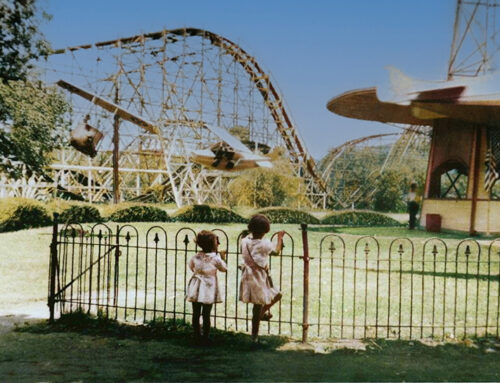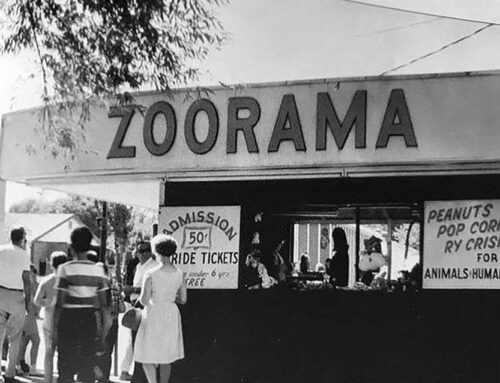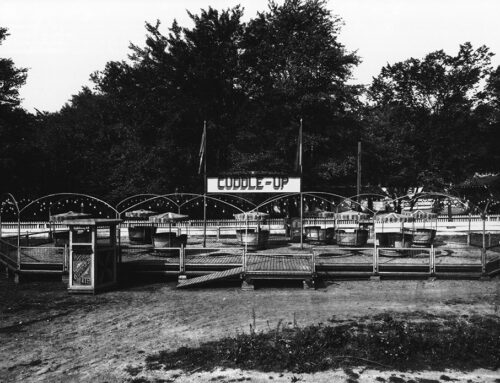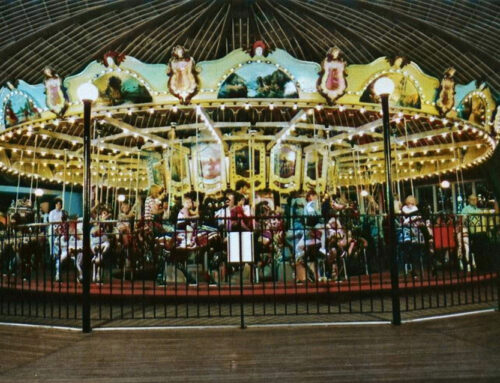Throughout much of the 20th century, Dorney Park in Allentown, Pennsylvania, was home to some of the most creative and beloved dark rides—indoor attractions where guests traveled through themed environments, typically aboard guided vehicles. Featuring animation, sound, music, and special effects, these rides offered immersive storytelling filled with humor, thrills, and surprises. Blending classic “Pretzel” ride technology with the legendary artistry of Bill Tracy, Dorney’s dark rides became iconic pieces of the park’s history. Though these attractions are now gone, the memories they created continue to resonate with those who experienced them.
Below: Bill Tracy.

Bucket O’ Blood (1963)
One of the earliest and most iconic dark rides was Devil’s Cave, which opened in the 1930s. This spooky Pretzel ride took visitors through a twisting labyrinth filled with quirky scenes, like a scarecrow sitting on an outhouse, and was famously guarded by Laffing Sal, a mechanical figure that laughed continuously outside the entrance. Over the years, the ride was rethemed as Pirates Cove in 1963 and later Bucket O’ Blood in 1974, when Bill Tracy transformed it into a vivid nautical adventure. Themed cars, shaped like buckets and named after pirates such as Captain Kidd and Henry Morgan, carried guests through detailed pirate scenes featuring stormy seas, skeleton sailors, drunken pirates, and Tracy’s famous “seasick pirate” heaving over the side of a ship. Spinning mechanisms in the cars were locked to ensure riders could fully enjoy the detailed dioramas, all glowing under black lights and neon Day-Glo paint. Sadly, this beloved ride was destroyed by fire in 1983, but it remains one of the most fondly remembered attractions in Dorney’s history.
Below: Bucket O’ Blood at Dorney Park.

Whacky Shack (1964)
Nearby was Whacky Shack, which opened in 1964 and stood right across from Bucket O’ Blood. Originally housed in a former skating rink, Whacky Shack was a walkthrough funhouse filled with humorous and dizzying illusions. With slanted floors, tilted walls, and cockeyed scenes, it embodied the whimsical style of Bill Tracy. The Shack only used about one-third of the old rink’s space but was packed with gags and optical tricks that delighted visitors. To keep it cool in the summer, a large roof fan was installed, and in a clever security move, a wire ceiling was added so staff could monitor guests from above to prevent vandalism. Sadly, Whacky Shack was lost to a fire around 1973, another unfortunate chapter in the park’s dark ride history, but it remains fondly remembered by those who experienced its wacky charm.
Below: Whacky Shack at Dorney Park.

Journey to the Center of the Earth (1960)
Another long-running favorite was The Mill Chute, which debuted in 1927. By the late 1950s, Dorney Park’s Mill Chute ride had grown outdated. With the rise of themed attractions following Disneyland’s 1955 debut, the park revamped the ride in 1960 with help of Bill Tracy, transforming it into Journey to the Center of the Earth, inspired by Jules Verne’s novel. The reimagined ride featured a dramatic volcanic facade, eerie soundscapes, glowing creatures, and a thrilling splashdown.


Throughout the 1960s and ’70s, it became one of the park’s most beloved attractions. In the 1980s, it was rethemed again with an icy cave look and more haunted elements like spiders, trolls, and monsters, enhancing its spooky appeal.

Sadly, by 1992, after more than 30 years as Journey to the Center of the Earth, and even longer as Mill Chute, the ride quietly closed for good. Dorney Park had just been purchased by Cedar Fair, and with new ownership came new priorities. Park officials said the ride was too costly to maintain, its parts were impossible to replace, and its low capacity didn’t fit with the park’s growing crowds. Without any farewell or official announcement, the last riders unknowingly took their final journey through the dark tunnels that year. Fans were heartbroken. Many remembered the ride’s spooky ambiance, its signature smell, and the mix of excitement and mystery that defined every trip into the earth’s depths.
The Iceberg (1968)
Not all of Dorney’s dark rides were traditional. In 1968, the park introduced Iceberg, a creative retheme of the classic Cuddle-Up ride. Enclosed inside a giant iceberg structure complete with penguins, polar bears, and the dramatic bow of the Titanic crashing through a wall, the ride offered a cool escape from summer heat, featuring air conditioning, disco lights, and music. Inside, guests spun around as if on an icy adventure. Originally designed in part by Bill Tracy and completed by JMM Studios, Iceberg was so unique that Dorney even patented the concept in 1978. The Iceberg was later renamed Meteorite before closing permanently in 1993.

Glass House (1975)
The Glass House, a mirrored maze attraction, was added to the park in 1975. It was a prefabricated structure purchased from Bertazzon in Italy and assembled on-site. Initially offering fun and confusion for guests, it stood out among the park’s quirky walkthrough attractions. At one point, it was renamed “Palacio de Cristal,” a playful attempt at Italian. While it was well-received early on, over time its revenue and public appeal declined as its novelty wore off.
Gold Mine (1969)
In 1969, Dorney transformed a former stockroom beneath the arcade into the Gold Mine, a humorous walkthrough designed to make people laugh rather than scream—true to Bill Tracy’s whimsical style. The Gold Mine became a humorous adventure through a twisting, turning maze of underground caverns, where guests encountered a series of comical mining mishaps. To bring the space to life, armatures were set up throughout the basement, and the same crew that had worked on the park’s Iceberg attraction came in to spray and sculpt the walls, transforming the once plain storage room into a convincing mine shaft. True to Bill Tracy’s style, the Gold Mine was filled with animated gags and visual jokes. Scenes included bumbling miners attempting (and failing) to strike it rich, a miner comically bested by a toilet—one of Tracy’s signature “trick” props—and of course, a precariously stacked pile of TNT boxes ready to topple at any moment. Adding to the humor, a group of miners were shown celebrating their “find” with some old-fashioned moonshine, a playful nod to Tracy’s well-known fondness for including drink-related gags in his rides. The Gold Mine closed in the mid 1980s.

Alfundo (1960)
Alfundo, created by Tracy in 1960 to serve as Dorney Park’s mascot, was a large clown figure that became the iconic trademark of Dorney Park for many years. The idea for Alfundo originated when Bill Tracy was asked to design something special for the park’s entrance, which at that time was located on Dorney Park Road, facing directly toward the coaster and scooter building. Tracy created a concept for a massive clown head made of fiberglass, positioned on top of the entrance building. After presenting and getting approval for a model, Tracy went on to construct the towering figure, complete with outstretched arms that appeared to juggle five illuminated balls. These three-foot-diameter balls were made from translucent fiberglass and were designed to flash in sequence, adding to the visual spectacle. The name Alfundo itself was a creative blend of ALlentown, FUN, and DOrney, embodying the spirit of the park.

Though these attractions are now part of history, Dorney Park’s dark rides represented a golden era of amusement park imagination, where handcrafted sets, mechanical gags, and artistic flair created unforgettable experiences. These were more than just rides — they were immersive stories that combined fright, fun, and fantasy. Whether braving the stormy seas of Bucket O’ Blood, spinning inside the Iceberg, wandering through the Whacky Shack, or floating through the Journey to the Center of the Earth, these rides left an indelible mark on Dorney Park’s legacy and in the memories of all who rode them.







Leave A Comment